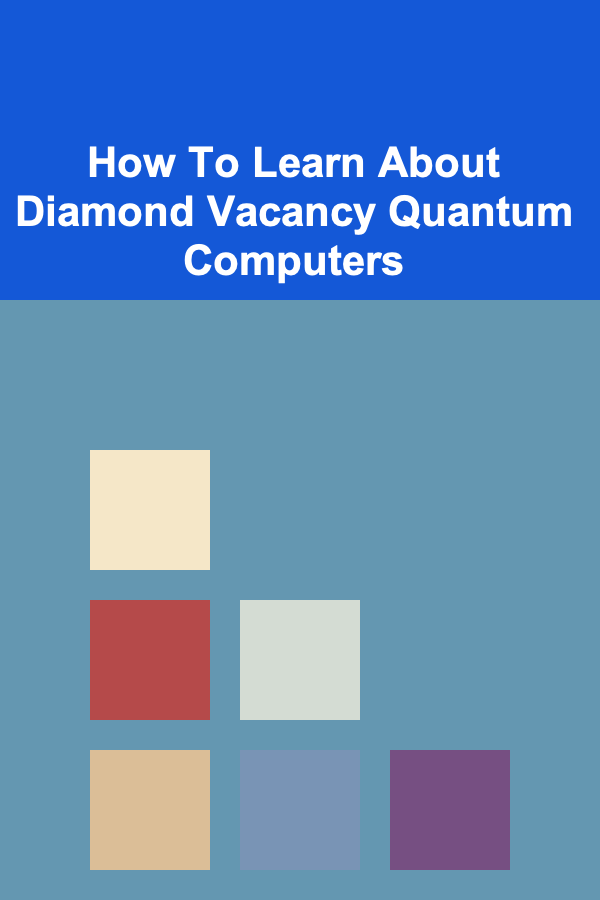
How To Learn About Diamond Vacancy Quantum Computers
ebook include PDF & Audio bundle (Micro Guide)
$12.99$11.99
Limited Time Offer! Order within the next:

Quantum computing is revolutionizing the way we think about computation. With its promise to solve complex problems faster than classical computers, quantum computers are poised to make a significant impact on fields like cryptography, material science, and machine learning. One of the most exciting developments in quantum computing is the use of diamond vacancy centers to create qubits, the fundamental units of quantum computation. These centers, often referred to as nitrogen-vacancy (NV) centers in diamond, have unique properties that make them ideal for quantum computing and other quantum technologies.
In this article, we will explore the concept of diamond vacancy quantum computers, how they work, the scientific principles behind them, and how to learn more about this cutting-edge technology. Whether you're a student, researcher, or simply curious about quantum computing, this guide will provide you with a roadmap to understanding and exploring this fascinating subject.
Understanding Quantum Computing
Before delving into the specifics of diamond vacancy quantum computers, it's important to understand the basics of quantum computing. At its core, quantum computing is based on the principles of quantum mechanics, the branch of physics that deals with the behavior of matter and energy at the smallest scales (atoms and subatomic particles).
Classical vs. Quantum Computing
In classical computing, information is stored and processed as bits, which can represent one of two values: 0 or 1. These bits are manipulated by logical operations to perform computations. However, classical computers are limited by the processing power of these bits, and some problems are too complex for classical computers to solve in a reasonable amount of time.
Quantum computers, on the other hand, use quantum bits, or qubits . Unlike classical bits, qubits can represent not just 0 or 1, but also a superposition of both values simultaneously. This unique property, known as superposition , allows quantum computers to process information in parallel, solving certain problems exponentially faster than classical computers. Additionally, qubits can be entangled , meaning the state of one qubit can be linked to the state of another, no matter how far apart they are. This phenomenon, called entanglement, enables quantum computers to perform tasks that classical computers cannot.
The Role of Qubits in Quantum Computers
Qubits are the building blocks of quantum computers. Their behavior is governed by the laws of quantum mechanics, and they can exist in multiple states simultaneously, unlike classical bits. There are several physical systems that can be used to create qubits, including superconducting circuits, trapped ions, and diamonds with vacancy centers.
What Are Diamond Vacancy Centers?
At the heart of diamond vacancy quantum computers are diamond vacancy centers . These are imperfections in the crystal lattice of a diamond that can be manipulated to act as qubits. More specifically, the nitrogen-vacancy (NV) center is a type of diamond vacancy that has become particularly popular in quantum computing research.
The Structure of a Diamond
A diamond is made up of carbon atoms arranged in a crystal lattice. Each carbon atom is covalently bonded to four neighboring carbon atoms in a tetrahedral structure. In a perfect diamond lattice, all carbon atoms are in their correct positions. However, in real diamonds, imperfections or defects can occur, which are often referred to as vacancies.
A vacancy in a diamond is simply a missing carbon atom. When a nitrogen atom occupies a vacancy in the lattice, it creates a nitrogen-vacancy (NV) center. The NV center consists of a nitrogen atom and an adjacent vacancy site where the carbon atom is missing. This defect is of great interest because it exhibits quantum mechanical properties, making it a suitable candidate for qubits in quantum computing.
The Quantum Properties of NV Centers
NV centers have several properties that make them ideal for quantum computing:
- Spin States: The NV center has an electron with a spin that can be manipulated to represent a qubit. The spin states of the electron can be controlled using electromagnetic fields and lasers. The spin can exist in a superposition of states, allowing for quantum computation.
- Optical Readout: One of the unique features of NV centers is their ability to be read optically. The spin state of the electron can be measured by shining light on the NV center and analyzing the fluorescence emitted. This optical readout is particularly useful for quantum computing, as it allows for the fast and non-invasive measurement of qubits.
- Long Coherence Times: Coherence time refers to how long a quantum state can maintain its integrity before it is disrupted by external factors (decoherence). NV centers have relatively long coherence times compared to other qubit systems, making them more stable and practical for quantum computing.
- Room Temperature Operation: Unlike many quantum systems that require extremely low temperatures to function, NV centers can operate at room temperature, which simplifies their use in practical quantum computing applications.
How Diamond Vacancy Quantum Computers Work
Diamond vacancy quantum computers leverage the unique properties of NV centers to perform quantum computations. The basic operation of a diamond vacancy quantum computer involves manipulating the spin states of the NV centers to represent qubits and performing quantum gates to process information.
Initial State Preparation
In a diamond vacancy quantum computer, a qubit is created by initializing the spin state of an NV center. This can be done by applying a magnetic field and using a laser to manipulate the electron's spin. The qubit can then be put into a superposition state, where it represents both 0 and 1 simultaneously.
Quantum Gates and Operations
Once the qubits are initialized, quantum gates are applied to manipulate the qubits and perform computations. Quantum gates are the quantum analogs of classical logic gates, and they operate by changing the state of the qubits. In diamond vacancy quantum computers, quantum gates are implemented by applying electromagnetic pulses to the NV centers, which affect the spin of the electron.
For example, a Hadamard gate can be applied to a qubit to create a superposition state, while a CNOT gate can entangle two qubits. These operations form the building blocks of quantum algorithms.
Measurement and Readout
After quantum operations are performed, the final state of the qubits is measured. In a diamond vacancy quantum computer, this is typically done using optical readout. A laser is used to excite the NV center, and the fluorescence emitted is analyzed to determine the spin state of the electron. By measuring the spin state, the quantum information encoded in the qubits can be extracted.
How to Learn About Diamond Vacancy Quantum Computers
Learning about diamond vacancy quantum computers involves studying a combination of quantum mechanics, quantum computing, material science, and nanotechnology. Here are some steps you can take to deepen your understanding of this exciting field:
1. Study Quantum Mechanics
Quantum mechanics is the foundation of quantum computing, and understanding its principles is crucial to grasp how diamond vacancy quantum computers work. Key concepts to study include:
- Wave-particle duality
- Superposition and entanglement
- Quantum states and quantum measurement
- Quantum tunneling and interference
There are many textbooks, online courses, and video lectures available to learn quantum mechanics at various levels, from introductory to advanced.
2. Explore Quantum Computing
Once you have a solid understanding of quantum mechanics, you can dive deeper into the field of quantum computing. Start by studying the following topics:
- Qubits and quantum gates
- Quantum algorithms (e.g., Shor's algorithm, Grover's algorithm)
- Quantum error correction
- Quantum hardware and qubit technologies
Online platforms like Coursera, edX, and MIT OpenCourseWare offer free courses on quantum computing, and many universities have specialized programs in this area.
3. Learn About Material Science and Nanotechnology
To understand how NV centers are created and manipulated, you need to have a background in material science and nanotechnology. Learn about the properties of diamonds, defects in crystal lattices, and how materials are engineered at the nanoscale. Look into research on vacancy defects and nitrogen-doped diamonds.
4. Read Research Papers and Articles
Stay up-to-date with the latest developments in diamond vacancy quantum computers by reading research papers and articles. Look for papers published in journals like Nature Quantum Information , Physical Review Letters , and Science Advances. These sources provide insights into the latest experiments and breakthroughs in quantum computing.
5. Participate in Online Communities
Engage with other quantum computing enthusiasts and researchers by joining online communities such as:
- Quantum Computing Stack Exchange: A forum for asking questions and discussing quantum computing topics.
- Reddit: Subreddits like r/QuantumComputing and r/Quantum can help you connect with other learners and experts.
- Meetups and Conferences: Attend quantum computing meetups or conferences to network with experts and learn from industry leaders.
6. Hands-on Experience with Quantum Simulators
Many quantum computing platforms offer simulators that allow you to experiment with quantum algorithms and operations. Companies like IBM (with their Qiskit platform) and Google (with Cirq) provide access to quantum simulators and even actual quantum computers through the cloud.
Experimenting with these platforms will help you gain practical experience and deepen your understanding of how quantum algorithms are implemented.
Conclusion
Diamond vacancy quantum computers represent a cutting-edge approach to quantum computing, utilizing the unique properties of NV centers in diamonds to create stable and versatile qubits. While the field is still in its early stages, diamond vacancy quantum computers have the potential to revolutionize computing by solving problems that are currently intractable for classical computers.
By learning about quantum mechanics, quantum computing, material science, and diamond vacancies, you can gain a deep understanding of this exciting technology. With the right resources and dedication, you can become part of the next generation of scientists and engineers who will shape the future of quantum computing.
The journey to mastering diamond vacancy quantum computers is complex, but it is also an incredibly rewarding endeavor. As the field advances, the possibilities for innovation and discovery are limitless.

How to Add Decorative Lighting to Your Home Without Breaking the Bank
Read More
How to Plan a Themed Party for Adults
Read More
How to Prioritize Your Spending with the 50/30/20 Rule
Read More
How to Store and Organize Your Home's Cleaning Supplies Efficiently
Read More
How to Turn Meal Prep into Family Bonding Time
Read More
How To Analyze Your Own Gameplay for Flaws
Read MoreOther Products

How to Add Decorative Lighting to Your Home Without Breaking the Bank
Read More
How to Plan a Themed Party for Adults
Read More
How to Prioritize Your Spending with the 50/30/20 Rule
Read More
How to Store and Organize Your Home's Cleaning Supplies Efficiently
Read More
How to Turn Meal Prep into Family Bonding Time
Read More